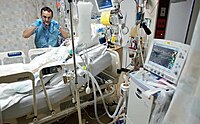
Photo from wikipedia
BACKGROUND As of June 1, 2020, over 370000 coronavirus disease 2019 (COVID-19) deaths have been reported to the World Health Organization. However, the risk factors for patients with moderate-to-severe or… Click to show full abstract
BACKGROUND As of June 1, 2020, over 370000 coronavirus disease 2019 (COVID-19) deaths have been reported to the World Health Organization. However, the risk factors for patients with moderate-to-severe or severe-to-critical COVID-19 remain unclear. AIM To explore the characteristics and predictive markers of severely and critically ill patients with COVID-19. METHODS A retrospective study was conducted at the B11 Zhongfaxincheng campus and E1-3 Guanggu campus of Tongji Hospital affiliated with Huazhong University of Science and Technology in Wuhan. Patients with COVID-19 admitted from 1st February 2020 to 8th March 2020 were enrolled and categorized into 3 groups: The moderate group, severe group and critically ill group. Epidemiological data, demographic data, clinical symptoms and outcomes, complications, laboratory tests and radiographic examinations were collected retrospectively from the hospital information system and then compared between groups. RESULTS A total of 126 patients were enrolled. There were 59 in the moderate group, 49 in the severe group, and 18 in the critically ill group. Multivariate logistic regression analysis showed that age [odd ratio (OR) = 1.055, 95% (confidence interval) CI: 1.099-1.104], elevated neutrophil-to-lymphocyte ratios (OR = 4.019, 95%CI: 1.045-15.467) and elevated high-sensitivity cardiac troponin I (OR = 10.126, 95%CI: 1.088 -94.247) were high-risk factors. CONCLUSION The following indicators can help clinicians identify patients with severe COVID-19 at an early stage: age, an elevated neutrophil-to-lymphocyte ratio and high sensitivity cardiac troponin I.
Journal Title: World Journal of Clinical Cases
Year Published: 2022
Link to full text (if available)
Share on Social Media: Sign Up to like & get
recommendations!